parking brake SATURN ASTRA 2008 Owners Manual
[x] Cancel search | Manufacturer: SATURN, Model Year: 2008, Model line: ASTRA, Model: SATURN ASTRA 2008Pages: 304, PDF Size: 1.92 MB
Page 93 of 304
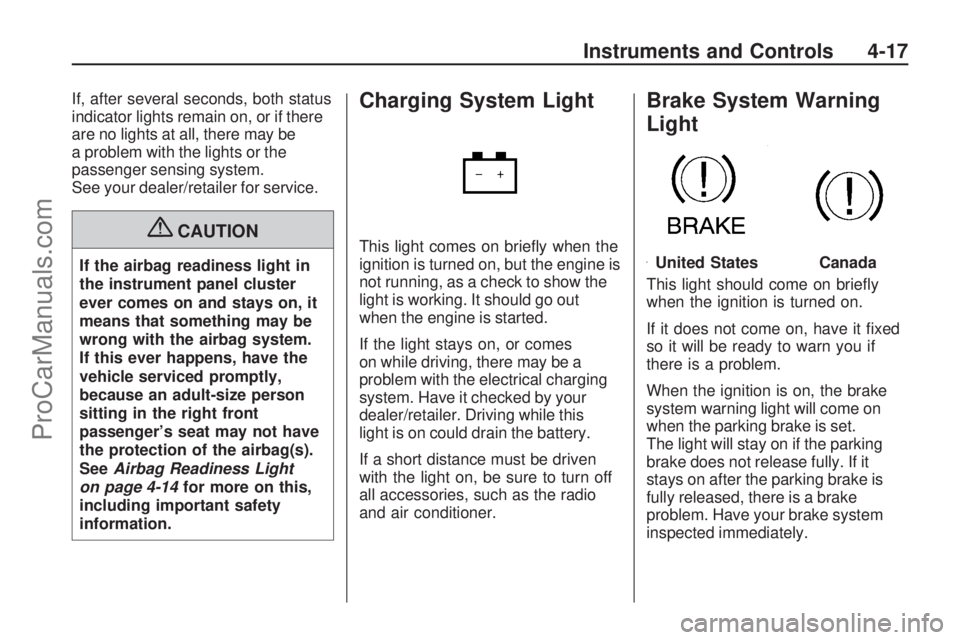
If, after several seconds, both status
indicator lights remain on, or if there
are no lights at all, there may be
a problem with the lights or the
passenger sensing system.
See your dealer/retailer for service.
{CAUTION
If the airbag readiness light in
the instrument panel cluster
ever comes on and stays on, it
means that something may be
wrong with the airbag system.
If this ever happens, have the
vehicle serviced promptly,
because an adult-size person
sitting in the right front
passenger’s seat may not have
the protection of the airbag(s).
SeeAirbag Readiness Light
on page 4-14for more on this,
including important safety
information.
Charging System Light
This light comes on brie�y when the
ignition is turned on, but the engine is
not running, as a check to show the
light is working. It should go out
when the engine is started.
If the light stays on, or comes
on while driving, there may be a
problem with the electrical charging
system. Have it checked by your
dealer/retailer. Driving while this
light is on could drain the battery.
If a short distance must be driven
with the light on, be sure to turn off
all accessories, such as the radio
and air conditioner.
Brake System Warning
Light
This light should come on brie�y
when the ignition is turned on.
If it does not come on, have it �xed
so it will be ready to warn you if
there is a problem.
When the ignition is on, the brake
system warning light will come on
when the parking brake is set.
The light will stay on if the parking
brake does not release fully. If it
stays on after the parking brake is
fully released, there is a brake
problem. Have your brake system
inspected immediately.
United StatesCanada
Instruments and Controls 4-17
ProCarManuals.com
Page 153 of 304

Driving and
Operating
Starting and Operating
Your Vehicle
New Vehicle Break-In.........8-2
Ignition Positions................8-2
Retained Accessory
Power (RAP).....................8-3
Starting the Engine.............8-3
Engine Heater....................8-4
Automatic Transmission
Operation..........................8-5
Manual Transmission
Operation..........................8-9
Parking Brake...................8-10
Shifting Into Park..............8-11
Shifting Out of Park..........8-13
Parking the Vehicle...........8-13
Parking Over Things
That Burn........................8-13
Engine Exhaust.................8-14
Running the Vehicle
While Parked..................8-14
Driving Your Vehicle
Defensive Driving..............8-16
Drunk Driving....................8-16
Control of a Vehicle..........8-17
Braking.............................8-17
Antilock Brake
System (ABS).................8-18
StabiliTrak®System..........8-19
Steering............................8-20
Off-Road Recovery............8-22
Passing.............................8-23
Loss of Control.................8-23
Driving at Night.................8-24
Driving in Rain and on
Wet Roads......................8-25
Before Leaving on a
Long Trip........................8-26
Highway Hypnosis.............8-26
Hill and Mountain
Roads.............................8-26
Winter Driving...................8-27
If Your Vehicle is Stuck
in Sand, Mud, Ice,
or Snow
..........................8-29
Rocking Your Vehicle to
Get It Out.......................8-30
Loading the Vehicle..........8-30
Fuel
Fuel..................................8-35
Gasoline Octane...............8-35
Gasoline Speci�cations.....8-35
California Fuel..................8-35
Additives...........................8-36
Fuels in Foreign
Countries........................8-36
Filling the Tank.................8-37
Filling a Portable Fuel
Container........................8-38
Driving and Operating 8-1
ProCarManuals.com
Page 155 of 304
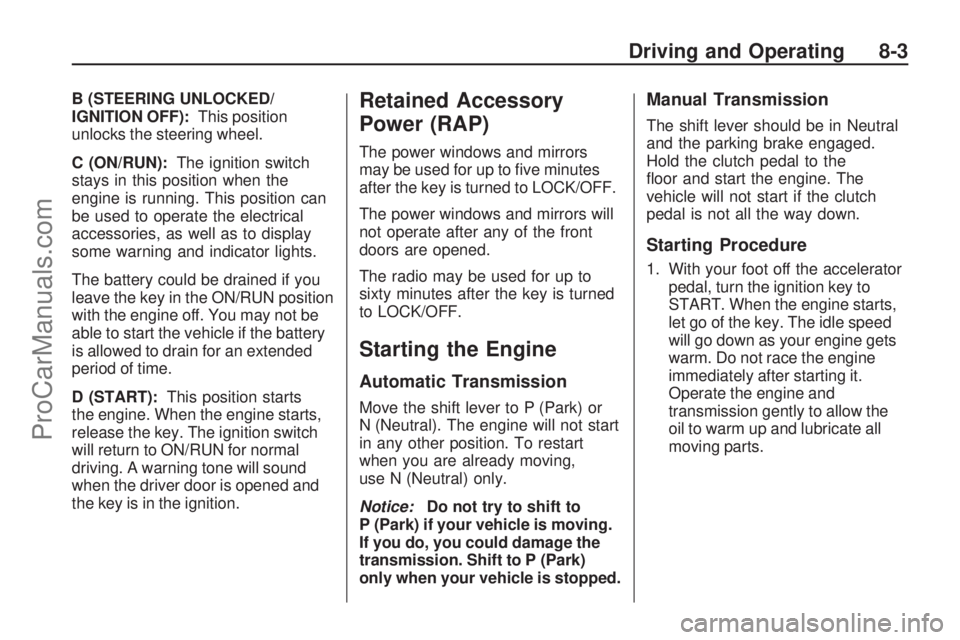
B (STEERING UNLOCKED/
IGNITION OFF):This position
unlocks the steering wheel.
C (ON/RUN):The ignition switch
stays in this position when the
engine is running. This position can
be used to operate the electrical
accessories, as well as to display
some warning and indicator lights.
The battery could be drained if you
leave the key in the ON/RUN position
with the engine off. You may not be
able to start the vehicle if the battery
is allowed to drain for an extended
period of time.
D (START):This position starts
the engine. When the engine starts,
release the key. The ignition switch
will return to ON/RUN for normal
driving. A warning tone will sound
when the driver door is opened and
the key is in the ignition.Retained Accessory
Power (RAP)
The power windows and mirrors
may be used for up to �ve minutes
after the key is turned to LOCK/OFF.
The power windows and mirrors will
not operate after any of the front
doors are opened.
The radio may be used for up to
sixty minutes after the key is turned
to LOCK/OFF.
Starting the Engine
Automatic Transmission
Move the shift lever to P (Park) or
N (Neutral). The engine will not start
in any other position. To restart
when you are already moving,
use N (Neutral) only.
Notice:Do not try to shift to
P (Park) if your vehicle is moving.
If you do, you could damage the
transmission. Shift to P (Park)
only when your vehicle is stopped.
Manual Transmission
The shift lever should be in Neutral
and the parking brake engaged.
Hold the clutch pedal to the
�oor and start the engine. The
vehicle will not start if the clutch
pedal is not all the way down.
Starting Procedure
1. With your foot off the accelerator
pedal, turn the ignition key to
START. When the engine starts,
let go of the key. The idle speed
will go down as your engine gets
warm. Do not race the engine
immediately after starting it.
Operate the engine and
transmission gently to allow the
oil to warm up and lubricate all
moving parts.
Driving and Operating 8-3
ProCarManuals.com
Page 158 of 304

PARK (P):This position locks the
front wheels. It is the best position
to use when the engine is started
because your vehicle cannot
move easily.
{CAUTION
It is dangerous to get out of
your vehicle if the shift lever is
not fully in PARK (P) with the
parking brake �rmly set. Your
vehicle can roll.
Do not leave your vehicle when
the engine is running unless
you have to. If you have left the
engine running, the vehicle can
move suddenly. You or others
could be injured. To be sure
your vehicle will not move, even
when you are on fairly level
ground, always set your parking
brake and move the shift lever to
PARK (P). SeeShifting Into Park
on page 8-11.Make sure the shift lever is fully in
PARK (P) before starting the engine.
Your vehicle has an automatic
transmission shift lock control
system. The regular brakes must be
applied before you can shift from
PARK (P) when the ignition key is in
ON/RUN. If you cannot shift out of
PARK (P) while holding the brake
pedal down, seeShifting Out of
Park on page 8-13.
REVERSE (R):Use this gear to
back up.
Notice:Shifting to R (Reverse)
while the vehicle is moving
forward could damage the
transmission. The repairs would
not be covered by the vehicle
warranty. Shift to R (Reverse)
only after the vehicle is stopped.
To rock your vehicle back and
forth to get out of snow, ice, or sand
without damaging the transmission,
seeRocking Your Vehicle to Get
It Out on page 8-30.NEUTRAL (N):In this position,
the engine does not connect with the
wheels. To restart while you are
already moving, use NEUTRAL (N)
only. Also, use NEUTRAL (N)
when your vehicle is being towed.{CAUTION
Shifting into a drive gear while
the engine is running at high
speed is dangerous. Unless
your foot is �rmly on the brake
pedal, the vehicle could move
very rapidly. You could lose
control and hit people or
objects. Do not shift into a
drive gear while the engine is
running at high speed.
8-6 Driving and Operating
ProCarManuals.com
Page 162 of 304
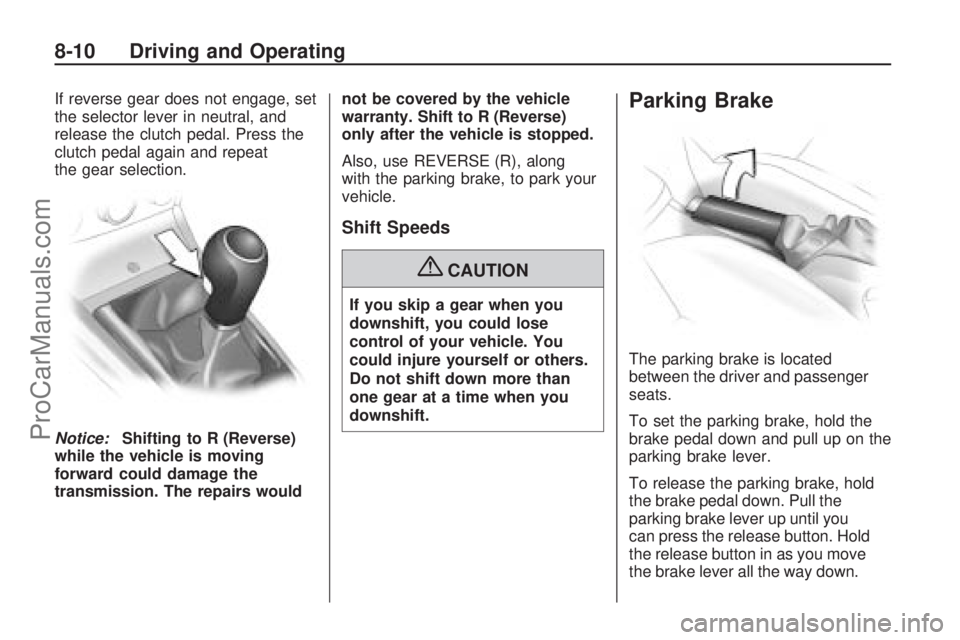
If reverse gear does not engage, set
the selector lever in neutral, and
release the clutch pedal. Press the
clutch pedal again and repeat
the gear selection.
Notice:Shifting to R (Reverse)
while the vehicle is moving
forward could damage the
transmission. The repairs wouldnot be covered by the vehicle
warranty. Shift to R (Reverse)
only after the vehicle is stopped.
Also, use REVERSE (R), along
with the parking brake, to park your
vehicle.
Shift Speeds
{CAUTION
If you skip a gear when you
downshift, you could lose
control of your vehicle. You
could injure yourself or others.
Do not shift down more than
one gear at a time when you
downshift.
Parking Brake
The parking brake is located
between the driver and passenger
seats.
To set the parking brake, hold the
brake pedal down and pull up on the
parking brake lever.
To release the parking brake, hold
the brake pedal down. Pull the
parking brake lever up until you
can press the release button. Hold
the release button in as you move
the brake lever all the way down.
8-10 Driving and Operating
ProCarManuals.com
Page 163 of 304
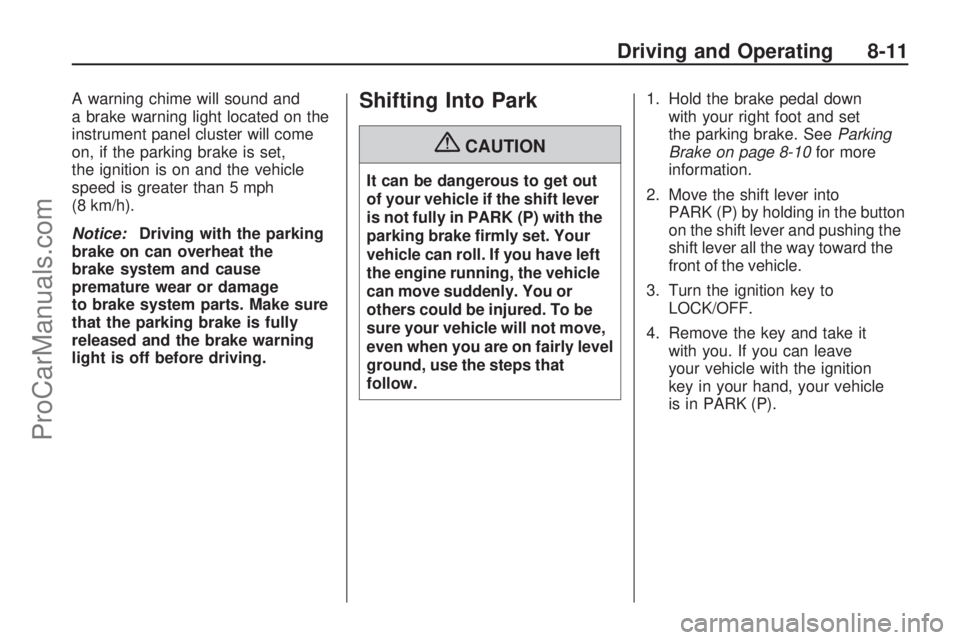
A warning chime will sound and
a brake warning light located on the
instrument panel cluster will come
on, if the parking brake is set,
the ignition is on and the vehicle
speed is greater than 5 mph
(8 km/h).
Notice:Driving with the parking
brake on can overheat the
brake system and cause
premature wear or damage
to brake system parts. Make sure
that the parking brake is fully
released and the brake warning
light is off before driving.Shifting Into Park
{CAUTION
It can be dangerous to get out
of your vehicle if the shift lever
is not fully in PARK (P) with the
parking brake �rmly set. Your
vehicle can roll. If you have left
the engine running, the vehicle
can move suddenly. You or
others could be injured. To be
sure your vehicle will not move,
even when you are on fairly level
ground, use the steps that
follow.1. Hold the brake pedal down
with your right foot and set
the parking brake. SeeParking
Brake on page 8-10for more
information.
2. Move the shift lever into
PARK (P) by holding in the button
on the shift lever and pushing the
shift lever all the way toward the
front of the vehicle.
3. Turn the ignition key to
LOCK/OFF.
4. Remove the key and take it
with you. If you can leave
your vehicle with the ignition
key in your hand, your vehicle
is in PARK (P).
Driving and Operating 8-11
ProCarManuals.com
Page 164 of 304

Leaving Your Vehicle with the
Engine Running
{CAUTION
It can be dangerous to leave the
vehicle with the engine running.
The vehicle could move
suddenly if the shift lever is not
fully in P (Park) with the parking
brake �rmly set. And, if you
leave the vehicle with the engine
running, it could overheat and
even catch �re. You or others
could be injured. Do not leave
the vehicle with the engine
running.If you have to leave your vehicle
with the engine running, be sure your
vehicle is in PARK (P) and your
parking brake is �rmly set before you
leave it. After you have moved the
shift lever into PARK (P), hold the
regular brake pedal down. Then, see
if you can move the shift lever away
from PARK (P) without �rst pushing
the button.
If you can, it means that the shift
lever was not fully locked in
PARK (P).
Torque Lock
If you are parking on a hill and you
do not shift your transmission into
PARK (P) properly, the weight of the
vehicle may put too much force on
the parking pawl in the transmission.
You may �nd it difficult to pull the
shift lever out of PARK (P).This is called torque lock. To prevent
torque lock, set the parking brake
and then shift into PARK (P) properly
before you leave the driver’s seat.
To �nd out how, seeShifting Into
Park on page 8-11.
When you are ready to drive, move
the shift lever out of PARK (P)before
you release the parking brake.
If torque lock does occur, you may
need to have another vehicle
push your vehicle a little uphill to
take some of the pressure from the
parking pawl in the transmission,
so you can pull the shift lever out of
PARK (P).
8-12 Driving and Operating
ProCarManuals.com
Page 165 of 304

Shifting Out of Park
This vehicle has an electronic shift
lock release system. The shift
lock release is designed to:
Prevent ignition key removal
unless the shift lever is in
PARK (P) with the shift lever
button fully released.
Prevent movement of the shift
lever out of PARK (P), unless
the ignition is in the ON/RUN
position and the regular brake
pedal is applied.
The shift lock release is always
functional except in the case of an
uncharged or low voltage (less
than 9 volt) battery.
If your vehicle has an uncharged
battery or a battery with low voltage,
try charging or jump starting the
battery. SeeJump Starting on
page 9-68for more information.To shift out of PARK (P) use the
following sequence:
1. Apply the brake pedal.
2. Press the shift lever button.
3. Move the shift lever to the
desired position.
If you still are unable to shift out of
PARK (P):
1. Fully release the shift lever
button.
2. While holding down the brake
pedal, press the shift lever
button again.
3. Move the shift lever to the
desired position.
If you still cannot move the shift
lever from PARK (P), consult your
dealer/retailer or a professional
towing service.
Parking the Vehicle
Before you get out of your vehicle,
move the shift lever into FIRST (1) or
REVERSE (R) and �rmly apply the
parking brake. Once the shift lever
has been placed into FIRST (1) or
REVERSE (R) with the clutch pedal
pressed in, you can turn the ignition
off and release the clutch.
Parking Over Things
That Burn
{CAUTION
Things that can burn could
touch hot exhaust parts under
your vehicle and ignite. Do not
park over papers, leaves, dry
grass, or other things that
can burn.
Driving and Operating 8-13
ProCarManuals.com
Page 167 of 304

CAUTION (Continued)
Also, idling in a closed-in place
can let deadly carbon monoxide
(CO) into your vehicle even if the
climate control fan is at the
highest setting. One place
this can happen is a garage.
Exhaust — with CO — can come
in easily. NEVER park in a
garage with the engine running.
Also see “If You Are Caught in a
Blizzard” underWinter Driving
on page 8-27.
{CAUTION
It can be dangerous to get out
of your vehicle if the shift lever
is not fully in PARK (P) with the
parking brake �rmly set. Your
vehicle can roll. Do not leave
your vehicle when the engine
is running unless you have to.
If you have left the engine
running, the vehicle can move
suddenly. You or others could
be injured. To be sure your
(Continued)
CAUTION (Continued)
vehicle will not move, even
when you are on fairly level
ground, always set the parking
brake and move the shift lever
to PARK (P).
Follow the proper steps to be sure
your vehicle will not move. See
Shifting Into Park on page 8-11.
Driving and Operating 8-15
ProCarManuals.com
Page 214 of 304
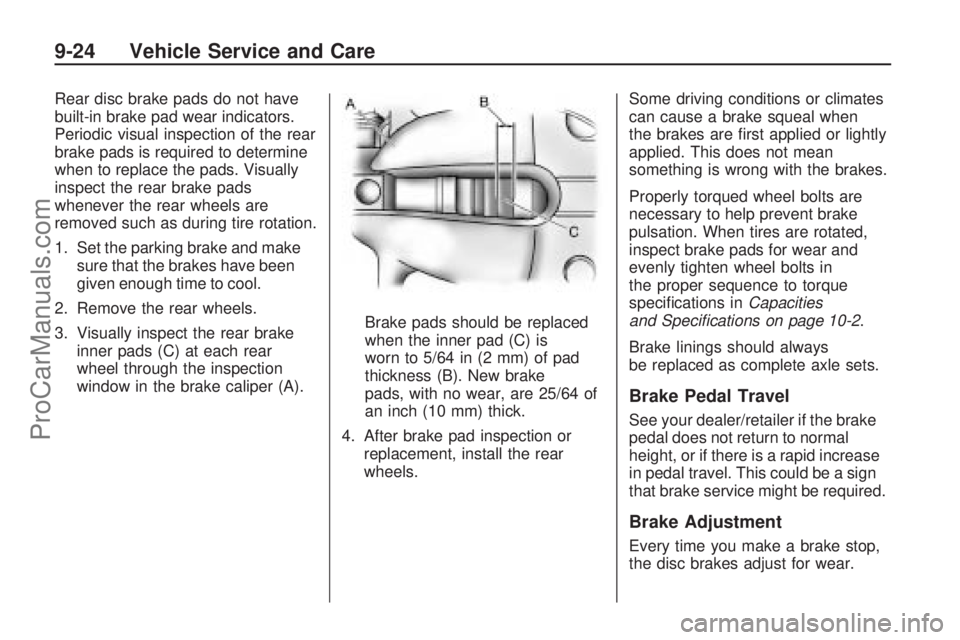
Rear disc brake pads do not have
built-in brake pad wear indicators.
Periodic visual inspection of the rear
brake pads is required to determine
when to replace the pads. Visually
inspect the rear brake pads
whenever the rear wheels are
removed such as during tire rotation.
1. Set the parking brake and make
sure that the brakes have been
given enough time to cool.
2. Remove the rear wheels.
3. Visually inspect the rear brake
inner pads (C) at each rear
wheel through the inspection
window in the brake caliper (A).Brake pads should be replaced
when the inner pad (C) is
worn to 5/64 in (2 mm) of pad
thickness (B). New brake
pads, with no wear, are 25/64 of
an inch (10 mm) thick.
4. After brake pad inspection or
replacement, install the rear
wheels.Some driving conditions or climates
can cause a brake squeal when
the brakes are �rst applied or lightly
applied. This does not mean
something is wrong with the brakes.
Properly torqued wheel bolts are
necessary to help prevent brake
pulsation. When tires are rotated,
inspect brake pads for wear and
evenly tighten wheel bolts in
the proper sequence to torque
speci�cations inCapacities
and Specifications on page 10-2.
Brake linings should always
be replaced as complete axle sets.
Brake Pedal Travel
See your dealer/retailer if the brake
pedal does not return to normal
height, or if there is a rapid increase
in pedal travel. This could be a sign
that brake service might be required.
Brake Adjustment
Every time you make a brake stop,
the disc brakes adjust for wear.
9-24 Vehicle Service and Care
ProCarManuals.com